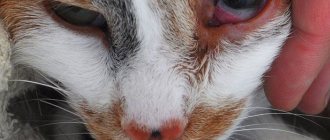In many cultures around the world, cats are considered one of the most mystical animals. And of course, this is primarily due to their eyes glowing in the darkness. In ancient times, people could not explain this feature of cats and attributed to them all sorts of unusual properties.
However, in our time, when scientists have figured out the nature of the origin of this phenomenon, there is still a reverent attitude towards these animals. Many still treat them as sacred, endowing them with divine characteristics.
Cat eye glow effect
A cat walking in a dark room or along the street at night can cause a certain frightening sensation, a slight horror. Her eyes “glow” with a greenish, yellowish or even red light. Scientists have long learned the secret of this phenomenon. The “glow” of a cat’s eyes comes from a layer of blood vessels located on the eyeballs behind the retina. This shell is called tapetum. It has a reflective property, which creates a glowing effect.
Photons penetrate the retinal tissue and are captured by the tapetum, which reflects the rays. Nature did not give this property to cats in order to provide them with a mysterious, mystical appearance. It is thanks to the presence of the tapetum that animals are ideally oriented in the dark, since the retina of the eye receives significantly more light compared to the human eye under the same lighting conditions. To distinguish objects, fluffies need illumination six times less than for humans. Cats are predators, and they need keen vision at night for successful hunting. It also serves as protection against sudden attacks by enemies and allows you to detect danger in a timely manner.
The tapetum cannot glow; the effect is created only when photons from a natural or artificial light source hit the shell. If the cat is in complete darkness, there will be no mystical sparkle in the eyes. But it will still be able to navigate perfectly, since the animal is helped by its well-developed sense of smell, hearing, and touch.
Green and red
The color of the reflected light is also explained by the properties of the tapetum. Tapetum L. produces a predominantly yellow, green, and bluish glow. Tapetum N. practically does not change the reflected light, so we see a red glow - from the blood vessels of the choroid. Depending on the angle of incidence of light and the location of the tapetum, we can see how the eyes glow green - when reflected from Tapetum L., or a reddish dim glow - these are reflections from Tapetum N. Interestingly, the eyes glow red even in humans - remember these reflections on Polaroid photos, red eye effect? It is also a reflection of the flash in our eyes. Humans do not have such a powerful tool for enhancing night vision as cats do, so our tapetum is practically invisible - unless you point a flashlight directly at the eye, of course.
The phenomenon of eye glow in other representatives of the fauna
Many consider the glow of the eyes to be the prerogative of cats, their individual phenomenon. But this is a misconception. The effect is observed in all representatives of the fauna, whose visual organs are equipped with a tapetum layer. It is available at:
- wild, large felines;
- dogs;
- deer and horses;
- rabbits; rats and mice;
- spiders;
- crustaceans and fish.
The difference between the glow of cat's eyes is expressiveness and effectiveness, which makes it more noticeable and attractive. In addition, we see these animals in the dark most often, which became the reason for attributing this phenomenon to beloved pets.
Human eyes do not have a tapetum, they do not have a reflective effect, and do not glow in the dark. After all, according to the laws of nature, people stay awake during daylight hours. This effect is gifted only to predators and animals that must escape from these night hunters.
Interesting information about the features of cat vision
For the most part, cats' eyes glow green or yellow. The intensity and shade are determined by the amount of zinc and riboflavin in the tapetum layer. There are also rare glow colors. For example, the eyes of Siamese cats emit red, crimson light in the dark. A decrease in the brightness of the effect comes with age. In older cats, the density of the lens increases, reducing the ability to reflect photons. The cause of dim light in young cats may be glaucoma or cataracts.
Cat eyes have several unique features:
- The visual acuity of these pets is almost 10 times higher than that of humans.
- The viewing angle of cats is 20° greater than that of humans. Our radius is 180°, for pets it is 200°.
- In terms of color perception, cat eyes are inferior to human eyes. Animals distinguish only a few shades. They see well the tones of green, black, blue, white, and gray. They do not perceive the remaining sectors of the color spectrum. It was previously believed that cats see the world in black and white, but recent research disproves this claim. There is no need to think that limited color vision causes inconvenience for cats. Pets don’t worry about the fact that they can’t distinguish between yellow and red, they don’t need it.
The quality of vision of these animals can be appreciated by two facts. A cat can see objects at a distance of half a kilometer or more. It can clearly see the smallest details of an object at a distance of 60 meters. The most vigilant person does not have such qualities.
There are some differences in the perception of static and moving objects. Animals can better see an object that is moving. Moreover, they see objects moving horizontally most clearly. The cat sees vertically moving objects worse.
It is known that dogs see nearby objects better, but their vigilance decreases when they move away. Cats' vision organs are structured differently. These pets are myopic. They have difficulty seeing objects located nearby, but are excellent at viewing distant targets.
Main reasons
All causes of the syndrome in the cat family can be divided into several groups:
- external causes (traumatic injuries and their consequences);
- ophthalmological causes (congenital and acquired structural changes of the eye, infectious pathologies);
- general infectious diseases;
- allergic reactions.
The diseases in each group are relatively homogeneous in origin, but differ in the nature of their course and the methods of treatment used.
Let's take a closer look at those that are most common.
External reasons
This type of hyperemia of the organ of vision occurs as a consequence of injury or exposure to various irritating substances on the cornea, namely:
- Foreign body getting into the eye. Debris or a foreign object stuck in a kitten's eye injures the delicate tissues, causing, in addition to redness, pain and lacrimation. Therefore, it is very important to remove it as soon as possible. In uncomplicated cases, the owner can cope with this on his own. But if the object has sharp edges or is located in the deep structures of the eye, then veterinary help is necessary. At the clinic, the pet will be given anesthesia, after which the foreign body will be surgically removed.
- Irritation of the cornea with soapy water when bathing or chemical agents when treating wool with insecticides. First aid consists of immediate rinsing with plenty of clean water. In the future, when carrying out various grooming procedures, it is necessary to protect the cat’s eyes from harmful influences.
- Hair hanging over the eyes of cats of long-haired breeds can prick and injure the cornea. If there is such a danger, you should always ensure that the long hairs around the eyes are neatly trimmed.
- Lens luxation. This condition can be of traumatic origin, but is sometimes a consequence of cataracts, uveitis or glaucoma. When the lens is dislocated, the iris has an abnormal appearance, and the displacement of the lens is visible to the naked eye. To reduce it, professional surgical assistance is required.
- Hyphema. With hyphema, blood accumulates in the anterior chamber. Causes may include injury or poor clotting. First of all, the cause of the hyphema is determined, then drug treatment is carried out with anti-inflammatory drugs and drugs that dilate the pupil.
- Proptosis is a partial or complete loss of the eyeball from the orbit as a result of traumatic impact. In this case, the disorder is treated surgically. If the damage is extensive, the eye may need to be removed.
Ophthalmic diseases as a cause of redness
- Blepharitis is an infectious or allergic inflammation of the eyelid. It is characterized by enlarged eyelids, discharge from the eyes, and itching. Once the cause of blepharitis is determined, medications are prescribed to eliminate it. In the case of an infectious nature of the disease, these are eye antibiotics and antifungal agents.
- Prolapse of the third eyelid gland (prolapse) is a disease in which the lacrimal gland loses its normal position, falls out of the conjunctival sac and becomes noticeable as a red formation in the corner of the eye. The prolapsed gland is removed surgically, but sometimes doctors decide to do without surgery. It is adjusted, returned to its normal position and fixed to prevent relapse.
- Conjunctivitis is inflammation of the conjunctiva. The disease may be infectious or allergic in origin. Characterized by thickened conjunctiva and lacrimation. The main method of treatment is the use of antibacterial or other drugs in accordance with the nature of the pathogen.
- Tumor of the eye and ocular structures. It can be localized in the eye or in the tissues surrounding the eye. Symptoms of the disease depend on which tissues and structures are affected. Treatment is usually surgical. If necessary, radiotherapy or chemotherapy is prescribed.
- A corneal ulcer is a violation of its surface layer. The cause of the disease may be infectious. The disease is accompanied by pain, photophobia and redness of the cornea. For treatment, local antibiotic therapy is used.
- Keratoconjunctivitis sicca most often affects older cats. Their lacrimal apparatus does not produce a sufficient amount of tear fluid, as a result of which the cornea dries out, and there is a burning sensation and irritation of the eyes in bright light. You can alleviate the animal’s condition by instilling an “artificial tear” drug to soften the cornea and replenish moisture deficiency.
- Glaucoma is the destruction of eye structures under the influence of high intraocular pressure. Accompanied by dilated pupils and clouding of the cornea. Older animals are more susceptible to pathology. In the severe stage, atrophy of the optic nerve occurs and complete blindness occurs. Symptomatic treatment is carried out by instilling drugs that reduce intraocular pressure. This allows you to slow down the destructive processes of the organ of vision.
Common infectious diseases of the body
Redness of the eyes is a symptom of some common infectious diseases. Here are some of them:
- Mycoplasmosis is a serious infectious disease, a complication of which is pneumonia. In addition to conjunctival tissue, the genitals, kidneys, and joints can be affected. If a cat has signs of a cold for a long time (cough, inflammation of the conjunctiva, nasal discharge, fever) and his eyes are red, then there is reason to assume that he has mycoplasmosis.
- Chlamydia is a chronic disease that affects the eyes, upper respiratory tract, and gastrointestinal tract. Pathogens are intracellular parasites that are resistant to any type of treatment. Red eye syndrome is caused by its conjunctival form, which can result in complete blindness.
- Calcivirosis is a viral disease, the target of which is the conjunctiva, mucous membranes of the nose and mouth, and joints. Transmitted by direct contact. The mortality rate from calcivirus among cats is very high. The main method of treatment is the prescription of local antiviral drugs and antibacterial agents (if a bacterial infection is attached).
Allergic reactions
Eye allergies to various substances (unusual food, medications, plants, household chemicals) have symptoms of allergic conjunctivitis. They are as follows: severe hyperemia of the conjunctiva and surrounding tissues, lacrimation, pain in the eyes, inability to look in bright light.
Allergic rhinitis often occurs when the animal cannot breathe through its nose, smell, and loses interest in food. Eye allergies can be expressed as allergic blepharitis (inflammation of the eyelid mucosa), allergic uveitis (inflammation of the iris). The main method of treatment is to identify the allergen, urgently remove it from the animal, and prescribe antihistamines that relieve painful symptoms.











